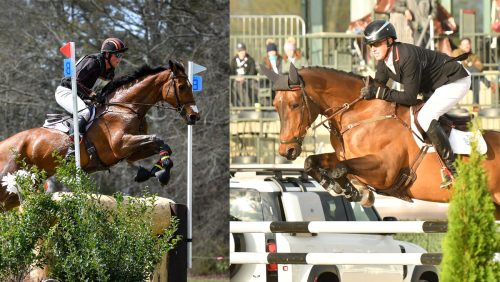I had one of the most educational, inspirational and enjoyable weeks of my life on June 23-28 at the George H. Morris Gladstone Program that took place at the stunning Annali-Brookwood Farm in Antioch, Ill.
I had a lot of ideas and anxieties about how the week would play out but I didn’t have any clue how much it would impact my riding and my horsemanship. I knew I would be surrounded by nine other riders that were some of the best young riders in the country, but I didn’t expect to genuinely enjoy, respect and build relationships that will last for a long time.
This program was one week that was for us; the riders. The structure of the program, which was so carefully designed by Diane Carney, provided us with an atmosphere to focus on what really mattered, which handed us tools that we wouldn’t have had the opportunity to utilize otherwise. Diane opened the door to this experience for us, pushed us to get as much as we possibly could out of the week and for that I will be eternally grateful. The Gladstone Program was everything I hoped it would be… and more.
(Want to read more about Ashley’s background? Check out her introductory blog, “Getting To The Next Level.”)
Driving up to Annali-Brookwood farm, I was greeted with a large banner that stated “2014 George H. Morris Gladstone Program” posted on the front fence. As I continued to drive, the view was one of the most stunning grass fields I have witnessed. With a huge water fountain, plush green grass, and over 20 sponsor boards on the side fence, I was already in awe. There were a few jumps set in the field, one of which was the Chinese wall from the 2008 Olympics Games in Hong Kong. I swallowed the lump in my throat and drove on. The barn looked as if it was a Breyer model farm with perfect landscaping, open windows with beautiful horse heads looking out and a smell of clean Pine Sol (my favorite).
We were responsible for our own horse care. We were in the barn every morning at 5:30 a.m., feeding and cleaning and being led by the wonderful and knowledgable stable management leader Laurie Pitts.
We were divided into two groups: Team 1: Leader Caitie Hope with Courtney Frederick, Steve Foran, Lisa Goldman and Hunter Holloway. Team 2’s leader was myself, with Caroline McLeese, KC Van Aarem, Adrienne Dixon and Lindsey Lamb. <
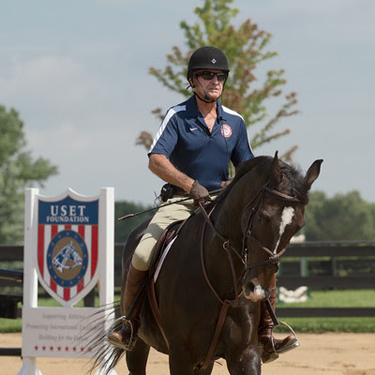 |
| George Morris demonstrated his flatwork theories for us on Carly Gordon’s horse Venture. Photo by Aullmyn Photography |
Day 1 consisted of a flatwork session. The focus was on correct hip and ankle angle, impulsion, getting the horse to “think” forward and inside leg being your first aid. As I walked my horse out to the arena, i had the same feeling that I feel before a grand prix: nervousness, pounding heart, sweat (or was that the 90 percent humidity?!) and most of all excitement. George went around and asked each of our names, he asked us which trainers we rode with.
“Ashley, you ride with Ronnie Freeman?” he asked.
I proudly said, “Yes, sir” as I knew he was old friends with my now-mentor.
The work he had us do was precise, clear and most of all, simple. He stated that contact equaled definite, straight, supple and steady. The hand position of straight line from hand to bit and also raising you hands and closing fingers when you feel a horse get hollow were a focus.
We were then given the opportunity to watch Anne Kursinski do a demonstration ride. It was as inspiring as I knew it would be. She stated that balance, lightness and self carriage is what her flatwork is all about. She also described that dressage is a tool in which to make the horse stronger and sounder. Anne spoke about the horses that she had ridden with George, it was so much fun to see George and Anne light up when she spoke of such horses as Eros. It was clear their teamwork and dedication to the flatwork and not over-jumping was what had lead to so many successes.
ADVERTISEMENT
Our lecture at the end of Day 1 was regarding speaking to the media. Brenda Mueller, who writes for Chicago Equestrian as well as Phelps Media, had a very original lesson plan for us. After discussing the importance of your message, sponsors, gratitude, body language and tone of voice, she set up a mock press conference. Brenda also focused on the importance of social media and knowing that anything you post is public information.
At the end of each day we trooped out to the outdoor sand arena to set the course for the following day.
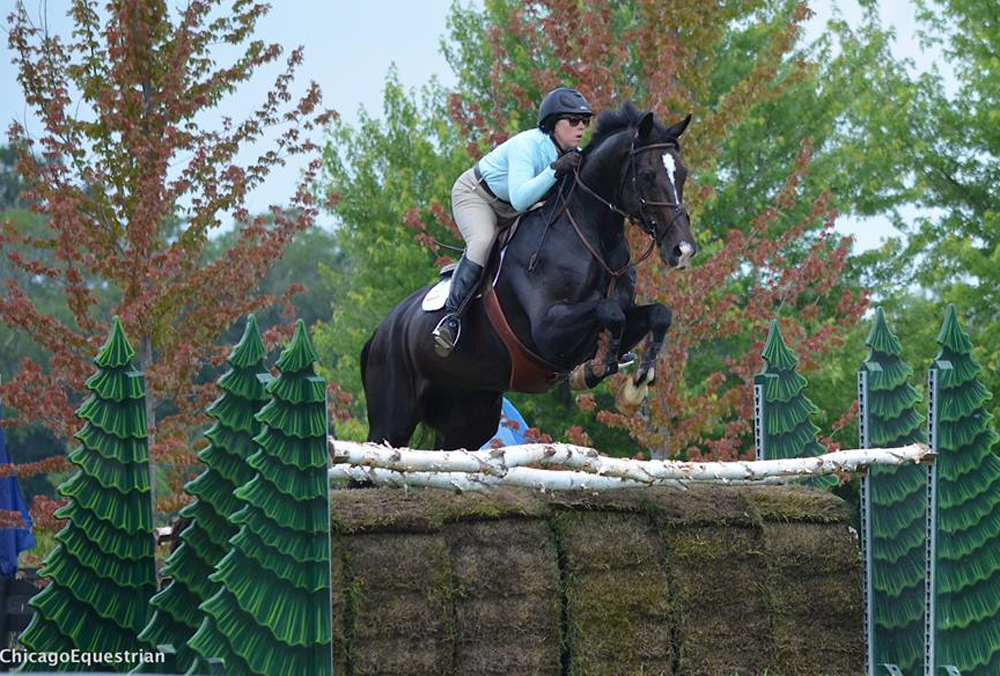 |
| George set courses that challenged us. Here I’m jumping a triple-bar. Photo by Chicago Equestrian |
These course-setting experiences were some of my favorites. Being around George, seeing which jump material he chose, where he put the jumps, and at which distances were so educational. He would then do a “course walk” at the end and tell us how to best ride each challenge. It was then that I knew this truly was a once-in-a-lifetime experience I had been given.
Day 2 consisted of a course of a serpentine of jumps, a four-stride line of a wall to a triple bar, a liverpool to liverpool five-stride and an end stone wall narrow jump. He discussed walking horses past spooky jumps, not approaching it head-on. He also spoke of the importance of getting your horse out of the arena and getting them used to all areas of a property or show grounds. He explained the differences of the short release, crest release and “jumping out of hand.” He discussed that the poll of the horse cannot bend if the jaw is stiff.
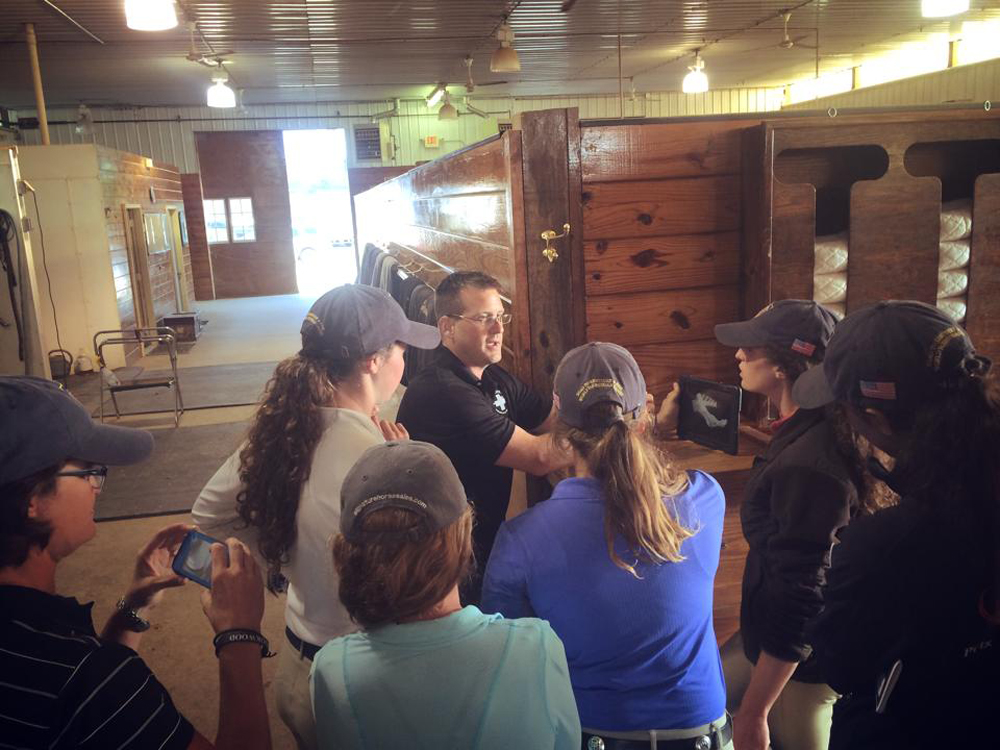 |
| Lectures from veterinarians like Dr. Mark Cassell (pictured) and Dr. Marvin Beeman were amazingly educational. |
We were so fortunate to have Dr. Marvin Beeman lecture us for both Days 2 and 3. His focus on conformation and the relationship of form to function which is based upon standard of excellence, dynamics of locomotion and soundness was exceptional.
I loved how Dr. Beeman spoke of a horse’s heart and their desire to do the job they are asked, often referring to the great Secretariat. He used example pictures that had plumb lines drawn to see correct conformation or conformation faults. He stated that most lamenesses are the direct effect of stress, strain and concussion on the musculoskeleton of the horse.
Dr. Beeman’s love of the horse, extreme knowledge and his pleasure at sharing this information with the eager riders was very apparent.
Day 3 was another course that consisted of a trot jump with a bending line to a vertical-oxer one stride. We practiced making half turns with flying changes off of the inside leg and repeating the exercise in the opposite direction. There was also a Swedish oxer that we practiced to a bending line to the narrow wall. Focusing on track and not having time faults was key. We wrapped up working over a triple combination oxer-oxer-oxer each set 21’ apart. All of the horses and riders executed the course well and it was again very clear that the caliber of riders was very high. George stated that this was not normal teaching and that we were collegiate level students, though not yet in grad school.
Day 4 started with a mock FEI jog. DiAnn Langer did a great job of explaining to us how to best present our horses, what to do when things go wrong, and we truly felt as if we were getting ready for an international competition!
After the jog, it was the dreaded no-stirrups day. Though I had done a lot of research prior to my clinic
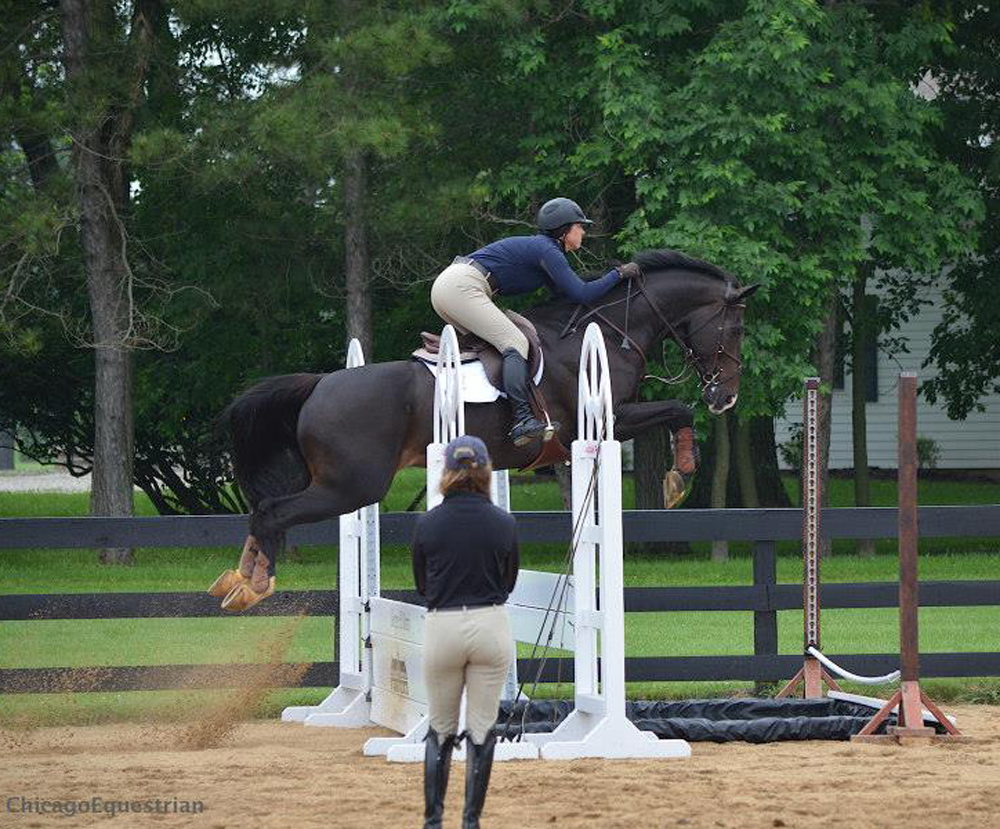 |
| Learning wasn’t limited to just when you were riding. Watching all the other riders was educational as well. Here I’m jumping the water. Photo by Chicago Equestrian |
and knew that George didn’t have riders post the trot for extended periods of time, it was still something I was anxious about. Luckily, the hours of practice I had put in during my months of preparation at home paid off and my legs didn’t let me down. Our flat session was again so helpful and you could visually see the horses start to get softer and more supple. George put great emphasis on the half-halt. He explained that through the half-halt the rider must stretch through the spine, deepen the seat, apply leg and then close the hands—particularly the outside hand. You have to look to give and make sure that the horse always stays in front of you.
Our lecture on Day 4 was with the very experienced Billy Liggett who is the farrier for Charlie Jayne. He passed around different examples of shoes and also described when to use certain caulks for showing in grass. This was of particular interest to us riders as we knew we would be jumping on the grass later in the week.
ADVERTISEMENT
Day 5 was our review day. We were back in our flat bridles which was a full cheek smooth snaffle with a flash or figure-eight and no running martingale. One of the focuses was on the pulley rein which George expressed was an emergency stop. By planting one hand and lifting the other it was a very useful tool.
We again practiced our lateral work. One of my favorite exercises that I hadn’t before utilized was going from the shoulder-in into a turn on the haunches or haunches-in to a turn on the forehand. This active movement really got the horse’s hind ends moving.
Day 5’s lecture was with Yvonne C. Ocrant who is an equine attorney at a large firm based in downtown Chicago. YHer powerpoint presentation was unbelievably useful, particularly for a professional like myself. She went through equine activity liability laws, exceptions to liability protections, proper signage, contracts, and insurance. It was great clarification to many questions I had. She spoke about how to form a proper syndicate for horse ownership and some of the tools she could provide to assist. I left her lesson feeling inspired and so grateful that I had a contact to someone with so much knowledge on how to do things the right way.
Day 6 was the “Grand Prix of Brookwood” over a course that encompassed all that we had worked on throughout the week: getting our horses responsive, supple, being in a forward seat and maintaining connection.
I came away from these six amazing days with many different emotions. First and foremost it was gratitude. Numerous sponsors, including Diane Carney, the U.S. Equestrian Federation, and the U.S. Equestrian Team Foundation made this experience possible. We NEED more programs like this in the United States.
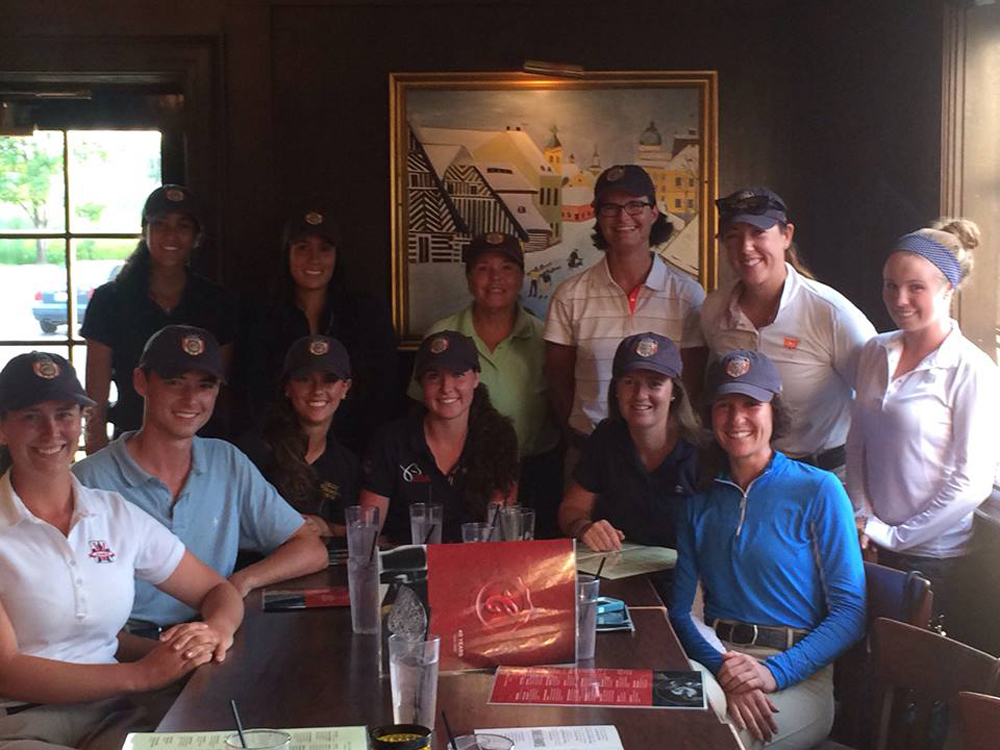 |
| I didn’t just learn—I made great friends! |
For me, the Gladstone program showed me that as a professional, I was on the right track, but there was so much more attention to detail that my program could benefit from. The concepts were there, but the daily work with George clarified so much.
Speaking with DiAnn Langer was inspiring and motivating as she spoke about representing the U.S. on a team, however, it was also realistic. We aren’t all going to be Olympians, but that doesn’t mean we stop reaching for higher education or striving to be the best grand prix riders we can.
I also came away from this experience with an amazing concept of teamwork. There was quite a large age gap between the riders from 16 to 32, but you would never know it. The genuine support was something I haven’t been exposed to before. I would go to bat for any one of those riders that I had the pleasure of meeting and being around, and I would trust anyone of them with the care and riding of my horse. They were truly incredible, humble and likable people! I can’t wait to cross paths with them in the future.
I also can’t say enough about the other people we were fortunate enough to be around. Harriet Bunker, a knowledgable professional from Colorado, was there to help us stay organized and her positive attitude never wavered. Laurie Pitts, our barn manager, happily shared with us her methods that have kept top show horses in the best physical condition for many years. The stories she shared of her grooming days for George and some of the other top riders in the country were some of our favorites. She was an example of classical horsemanship and a genuine love of horses.
Dr. Mark Cassell’s knowledge was unmeasured. His friendly and approachable demeanor made it easy for us riders to throw any questions we had at him. How amazing is it that the 10 of us riders had one of the best vets in the country simply there to be around us and our horses? It was after Day 3 at about 8:00 p.m. when all the riders were in the middle of the barn aisle with Dr. Mark and his iPad, which showed a 3D image of a horse’s pelvis, that I looked around and thought this is what it’s all about. None of us had to be there, we were done with our work, but here we were just soaking up every moment we could with people that were so willing to give.
That’s what the Gladstone Program is—giving young riders an opportunity to have access to these people and experiences. I can’t say thank you enough to the sponsors that helped make it possible, the owners of the horses that let us take them to this clinic, Diane Carney for her tireless efforts to make this experience top-notch, and to George Morris for believing that a group of 10 kids is worth six days of his valuable time. I can only hope to be involved with more programs like this in the future and will continue to be determined to do so.
Ashley Stannard is a young professional who owns and operates Ashbrook Farm in Tucson, Ariz. She and her Ashbrook Farm clients compete at shows throughout the Southwest. Ashley is also a member of the USHJA Zone 8 Jumper Committee.







